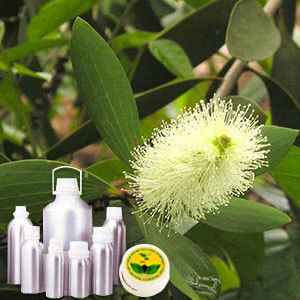Botonical Name | : | Melaleuca leucadendron var. cajeputi | |
CAS # | : | 8008-98-8 | |
Country of Origin | : | Indonesia | |
Color & Odor | : | Colorless to pale yellow clear liquid. With Fresh strong, dry-balsamic terpenic odor. | |
Solubility | : | Soluble in alcohol and oils. Insoluble in water. | |
Specific Gravity | : | 0.9050 - 0.9140 @ 20 ºC | |
Optical Rotation | : | +3.5° to +6.0° @ 20°C | |
Refractive Index | : | 1.4620 -1.4690 @ 20ºC | |
Flash Point | : | >100°C | |
Major Constituents | : | D-Limonene, 1,8-cineole, a-pinene | |
Plant Part Used | : | Leaves and Twigs | |
Extraction Method | : | Steam Distillation |
DESCRIPTION:
This essential oil is sourced from the Cajeput tree, which is a common name used for certain members of the genus Melaleuca. These trees are evergreens with pointed leaves having white, red or green flowers. The trees are widely known for their essential oils that have many aromatherapeutic and herbal uses. CONSTITUENTS:
It contains a-pinene, b-pinene, D-Limonene, 1,8-cineole, y-terpinene, Paracymene, linalool. AROMATIC SUMMARY / NOTE / STRENGTH OF AROMA:
Cajeput Essential Oil has a fresh, camphorous aroma resembling the combined fragrances of camphor, rosemary, and cardamom. BLENDS WITH:
It can mix well with various essential oils such as bergamot, cloves, geranium, lavender, and thyme. COMMON NAMES:
Melaleuca, white wood USES:
Cajeput oil is widely used in many aromatherapeutic and herbal preparations. This oil contains highest anti-infectious properties and is popular amongst health professionals around the world. 


































